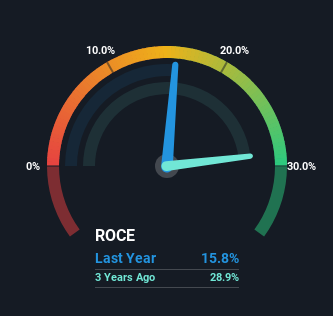Investors Could Be Concerned With Happiest Minds Technologies' (NSE:HAPPSTMNDS) Returns On Capital
Did you know there are some financial metrics that can provide clues of a potential multi-bagger? One common approach is to try and find a company with returns on capital employed (ROCE) that are increasing, in conjunction with a growing amount of capital employed. If you see this, it typically means it's a company with a great business model and plenty of profitable reinvestment opportunities. Having said that, from a first glance at Happiest Minds Technologies (NSE:HAPPSTMNDS) we aren't jumping out of our chairs at how returns are trending, but let's have a deeper look.
What Is Return On Capital Employed (ROCE)?
If you haven't worked with ROCE before, it measures the 'return' (pre-tax profit) a company generates from capital employed in its business. The formula for this calculation on Happiest Minds Technologies is:
Return on Capital Employed = Earnings Before Interest and Tax (EBIT) ÷ (Total Assets - Current Liabilities)
0.16 = ₹2.7b ÷ (₹22b - ₹5.7b) (Based on the trailing twelve months to June 2024).
Therefore, Happiest Minds Technologies has an ROCE of 16%. That's a pretty standard return and it's in line with the industry average of 16%.
Check out our latest analysis for Happiest Minds Technologies

Above you can see how the current ROCE for Happiest Minds Technologies compares to its prior returns on capital, but there's only so much you can tell from the past. If you'd like, you can check out the forecasts from the analysts covering Happiest Minds Technologies for free.
The Trend Of ROCE
The trend of ROCE doesn't look fantastic because it's fallen from 30% four years ago, while the business's capital employed increased by 467%. That being said, Happiest Minds Technologies raised some capital prior to their latest results being released, so that could partly explain the increase in capital employed. The funds raised likely haven't been put to work yet so it's worth watching what happens in the future with Happiest Minds Technologies' earnings and if they change as a result from the capital raise.
On a side note, Happiest Minds Technologies has done well to pay down its current liabilities to 25% of total assets. That could partly explain why the ROCE has dropped. Effectively this means their suppliers or short-term creditors are funding less of the business, which reduces some elements of risk. Since the business is basically funding more of its operations with it's own money, you could argue this has made the business less efficient at generating ROCE.
In Conclusion...
Even though returns on capital have fallen in the short term, we find it promising that revenue and capital employed have both increased for Happiest Minds Technologies. However, despite the promising trends, the stock has fallen 44% over the last three years, so there might be an opportunity here for astute investors. So we think it'd be worthwhile to look further into this stock given the trends look encouraging.
If you'd like to know about the risks facing Happiest Minds Technologies, we've discovered 2 warning signs that you should be aware of.
If you want to search for solid companies with great earnings, check out this free list of companies with good balance sheets and impressive returns on equity.
Valuation is complex, but we're here to simplify it.
Discover if Happiest Minds Technologies might be undervalued or overvalued with our detailed analysis, featuring fair value estimates, potential risks, dividends, insider trades, and its financial condition.
Access Free AnalysisHave feedback on this article? Concerned about the content? Get in touch with us directly. Alternatively, email editorial-team (at) simplywallst.com.
This article by Simply Wall St is general in nature. We provide commentary based on historical data and analyst forecasts only using an unbiased methodology and our articles are not intended to be financial advice. It does not constitute a recommendation to buy or sell any stock, and does not take account of your objectives, or your financial situation. We aim to bring you long-term focused analysis driven by fundamental data. Note that our analysis may not factor in the latest price-sensitive company announcements or qualitative material. Simply Wall St has no position in any stocks mentioned.
About NSEI:HAPPSTMNDS
Happiest Minds Technologies
Provides information technology (IT) solutions and services in India, the Americas, Australia, Europe, Asia, the Middle East, and Africa.
Reasonable growth potential with adequate balance sheet.
Similar Companies
Market Insights
Community Narratives



